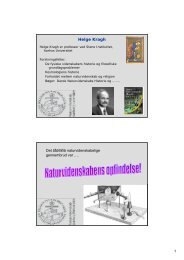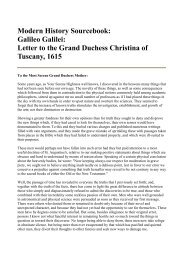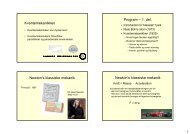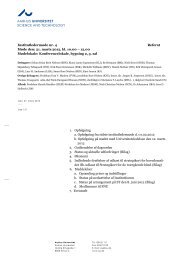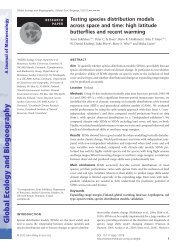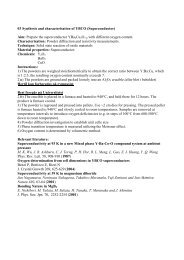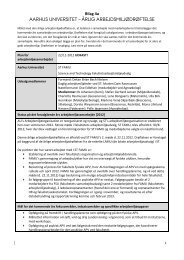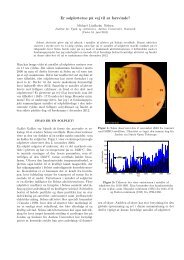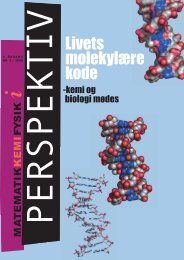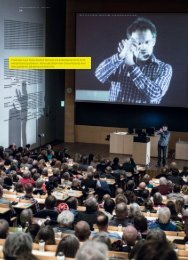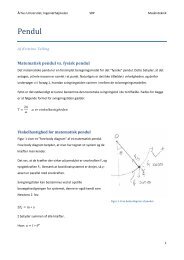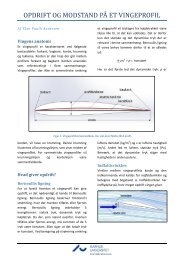OPTICAL TERAHERTZ SCIENCE AND TECHNOLOGY
OPTICAL TERAHERTZ SCIENCE AND TECHNOLOGY
OPTICAL TERAHERTZ SCIENCE AND TECHNOLOGY
Create successful ePaper yourself
Turn your PDF publications into a flip-book with our unique Google optimized e-Paper software.
Invitation<br />
<strong>OPTICAL</strong><br />
<strong>TERAHERTZ</strong> <strong>SCIENCE</strong><br />
<strong>AND</strong> <strong>TECHNOLOGY</strong><br />
- A playground for fundamental and applied science<br />
Invitation to a Danish Academy of Technical<br />
Sciences Conference 2009<br />
5 October 2009<br />
Venue: Technical University of Denmark, Kongens Lyngby, Building 101
Introduction<br />
ATV - Danish Academy of Technical Sciences and DTU<br />
Fotonik - Technical University of Denmark, Department<br />
of Photonics Engineering arrange this conference on the<br />
nascent terahertz technology. The aim is to identify the commercial<br />
possibilities of the so-called terahertz range. The<br />
terahertz range is a broad frequency band between microwaves<br />
and infrared light.<br />
The terahertz range has almost solely been used for scientific<br />
purposes so far - mainly due to a traditional lack of easily accessible<br />
light sources and detectors in this range. The latest<br />
technological breakthroughs have implied that it is necessary<br />
to change this perception.<br />
With this conference we hope to inspire future commercial<br />
initiatives for Danish companies so that they can benefit from<br />
this active technological development. Today terahertz technology<br />
is already utilised as an important tool for non-destructive<br />
testing, for certain safety purposes and in hundreds<br />
of research laboratories all over the world. The applications<br />
will definitely be widespread. Different market analyses independently<br />
indicate that there will be a market of several hundreds<br />
of millions of euros within the next 10-20 years.<br />
One of the important aims of the conference is to invite the<br />
participants to take an active part in the moderated debate<br />
that will follow the presentations during the day. At the end of<br />
the day a panel discussion will focus on future perspectives<br />
on Danish industry within this exciting field.<br />
Conference objective<br />
The overall objective of the conference is to bring together<br />
leading experts working in various directions of THz technology<br />
with a focus on upcoming applications with leading<br />
experts from industry. It is our hope that this opportunity to<br />
meet will serve as inspiration for further development of the<br />
growing commercial opportunities offered by the incorporation<br />
of THz technology in future applications.<br />
In between the cutting-edge presentations, the participants<br />
will have ample time to network with top scientists, policy<br />
makers, and businessmen from a range of companies and<br />
research institutions.<br />
The conference will focus on technology for medical applications,<br />
optical systems for terahertz technology, microscopy,<br />
applications of terahertz technology within European<br />
space programs, wireless terahertz communication and<br />
non-destructive error detection (for instance in composite<br />
materials).<br />
“ATV and DTU Fotonik will bring together the<br />
world’s top technologists from the nascent<br />
terahertz industry, the leading scientists in<br />
the field of terahertz technology and Danish<br />
and foreign companies and scientists”
Conference Program<br />
Conference Program<br />
8:30 Registration and morning coffee<br />
10:45 Coffee/tea break<br />
9:00 Welcome<br />
Address by Chief Scientist Lars Lading, Danish Technological Institute, Chairman of the ATV group on Electrical and Electronic<br />
Engineering and Information Technology<br />
9:15 Terahertz Technology<br />
”Looking forward with optical Terahertz technology”<br />
by Professor Peter Uhd Jepsen, Technical University of Denmark<br />
The THz frequency range contains a wealth of scientific as well as commercial opportunities. Parallel to an impressive<br />
development of science in the THz frequency range, there is a clear trend in THz research and development that new research<br />
becomes more and more oriented towards real-world applications. This can be interpreted as an indication of a maturing field.<br />
Peter Uhd Jepsen will briefly discuss where THz technology may take us in 20-30 years from now, and outline a few of the key<br />
technologies that will need to be developed in order to get there.<br />
“Seeing resonant currents in electric micro-circuits – Terahertz near-field microscopy”<br />
by Dr. Markus Walther, University of Freiburg, Germany<br />
Over the past years many studies have demonstrated the great potential of terahertz imaging for basic research, industry or<br />
security applications. In conventional imaging applications, however, diffration is limiting the achievable spatial resolution to<br />
orders of the wavelength. Only recently, terahertz near-field imaging techniques have been introduced that can overcome this<br />
diffraction limit.<br />
We have developed such a microscopy approach which allows us to measure the amplitude, phase and polarization of electric<br />
near-fields at terahertz frequencies with sub-wavelength spatial resolution. Besides the investigation of various microstructures,<br />
our approach also allows us to trace the electric field vectors close to optically excited metallic structures on sub-ps time scales.<br />
From the measured in-plane electric vector fields we are able to reconstruct the out-of-plane magnetic field vectors. As a result<br />
we obtain a comprehensive microscopic picture of the electromagnetic near-fields and ultimately the resonant currents flowing<br />
in electric micro-circuits.<br />
11.00 Emerging Terahertz Applications I<br />
“Terahertz wave imaging for non-destructive testing”<br />
by Dr. X.-C. Zhang, RPI, Troy, USA<br />
Since the first demonstration of THz wave time-domain spectroscopy in the late 80’s, there has been a series of significant<br />
advances of THz wave sensing and imaging. The development of intense THz sources and more sensitive detectors provide<br />
new opportunities for non-destructive testing in the THz frequency range. As pulsed and continuous THz wave technologies<br />
improve, new THz wave imaging capabilities impact a range of industrial sectors. This is particularly crucial for non-destructive<br />
evaluation (immediate application), national security (three to five years), and medical diagnosis or even clinical treatment in<br />
biomedical applications (five to ten years).<br />
“Terahertz technology for space“<br />
by Dr. Peter de Maagt, ESTEC, The Netherlands<br />
THz systems are finding and will continue to find wide-spread use in both space and terrestrial applications.<br />
The major reason for the interest in THz imaging technologies for terrestrial applications is their inherent spatial resolution, their<br />
ability to penetrate through non-metallic objects, their spectral identification capabilities, and their sensitivity to moisture.<br />
One of the issues that the space and terrestrial systems have in common is that they require state-of-the-art technology<br />
to achieve their ambitious goals; the highest resolution, the highest sensitivity, the highest frequency of operation. Although<br />
technology is advancing at a rapid pace in this frequency range, the requirements for these systems go well beyond what is<br />
currently available, such that there are also no standards or calibration reference sources in this field.<br />
In this talk the design, construction and testing of ESA’s Herschel and Planck observatories will be used as an example<br />
to highlight some of the hurdles that have to be overcome for a space application. Engineers from numerous European<br />
space companies have worked together overcoming many challenges that have pushed terahertz reflector and instrument<br />
technologies to new limits. Consequently significant advances have been achieved despite the lack of internationally agreed<br />
procedures and practices. Systems used in Earth Observation will also be discussed and the drivers identified. Future THz<br />
space systems will also be highlighted.<br />
12:30 Lunch
Conference Program<br />
Conference Program<br />
13:30 Emerging Terahertz Applications II<br />
“Applications of terahertz pulsed technology in the semiconductor and pharmaceutical industries”<br />
by Dr. Philip Taday, TeraView, Cambridge, UK<br />
The terahertz spectral region extends from the end of the far-IR spectral region (i.e. 133 cm -1 or 4 THz) to the beginning of<br />
the microwave spectral region (i.e. 1.3 cm -1 or 0.02 THz). Absorptions observed in this region are commonly associated with<br />
intermolecular hydrogen-bonding vibrations and crystalline structure lattice vibrations.<br />
TeraView’s terahertz pulsed spectroscopy (TPS) measurements obtained in both transmission and reflectance modes advance<br />
the current state-of-the-art for elucidating solid state crystalline structures such as polymorphs, hydrates, and solvates by<br />
providing fundamental spectra-structure correlations for hydrogen-bonding and other organic moieties.<br />
Terahertz pulsed imaging (TPI) provides a quick and non-destructive 3D mapping technique for determining the composition<br />
and integrity of intact materials. TPI yields unique information about materials.<br />
More recently, TeraView has been on the next generation of time-domain reflectrometers (TDR) for use in semiconductor failure<br />
analysis as a non-destructive method for the location of defects in semiconductor device packages.<br />
In this seminar, Phillp Taday will give an overview of terahertz technology and practical implementation considerations for TPS<br />
and TPI applications in industry.<br />
“Terahertz wireless communications”<br />
by Dr.-ing. Thomas Kleine-Ostmann, Physikalisch-Technische Bundesanstalt, Germany<br />
The increased need of unoccupied and unregulated bandwidth for future wireless short-range communication systems<br />
will require the extension of carrier frequencies to values of 300 GHz and beyond in the lower THz range. The Terahertz<br />
Communications Lab is a joint activity of three research groups at the Technical University of Braunschweig and one at the<br />
Physikalisch-Technische Bundesanstalt, the German National Metrology Institute, also in Braunschweig. It aims to do research<br />
on system aspects, technology, propagation and channel modelling at sub-mm wavelengths. As part of this cooperation, the<br />
Physikalisch-Technische Bundesanstalt covers metrological aspects within this frequency range. A 300 GHz transmission<br />
system designed for THz communication channel modelling and propagation studies has been set up and characterized with<br />
regard to link budget and noise. It consists of autarkic transmitter and detector units based on Schottky diode mixer technology.<br />
For demonstration, analogue and digital video signals have been transmitted over distances of up to 52 m. First channel<br />
measurements have been performed in an office environment. This talk gives an overview of recent and envisaged research<br />
activities within the Terahertz Communications Lab.<br />
15:00 Coffee/tea break<br />
“Industrial application of terahertz systems”<br />
by Professor Martin Koch, University of Marburg, Germany<br />
THz spectroscopy systems will soon find their way from research labs into industry. In the talk Professor Koch will give an<br />
overview of emerging real world applications for THz technology. Applications include the process control in the polymer<br />
industry, the detection of contaminations in food, and the monitoring of the plant water status, the latter being important for<br />
plant breeders. Besides, Professor Koch will review recent attempts to develop low cost THz systems.<br />
15:15 Moderated debate/panel discussion<br />
16:00 Closing remarks<br />
Moderator<br />
To facilitate an active discussion between the speakers of the conference and<br />
the participants, the sessions will be moderated by Professor Søren Rud Keiding,<br />
Department of Chemistry, Aarhus University.
Speakers<br />
Professor Peter Uhd Jepsen, Technical University of Denmark<br />
Peter Uhd Jepsen obtained the Master’s degree in 1994 from Odense University, Denmark, and the PhD degree in 1996 from Aarhus<br />
University, Denmark. He was postdoctoral fellow and later assistant and associate professor at the University of Freiburg, Germany<br />
1996-2004, and has been at the Technical University of Denmark since 2005. Currently he is heading the Terahertz Technologies and<br />
Biophotonics research group at DTU Fotonik - Department of Photonics Engineering, where he specializes in terahertz technologies<br />
for novel sensing applications, spectroscopic measurement techniques, and imaging applications. Peter Uhd Jepsen received<br />
Elektrofondets Elektropris in 2007.<br />
Dr. Philip Taday, TeraView Limited, UK<br />
Dr. Philip F. Taday earned his Bachelor of Science degree in physics (1986), and his PhD in chemistry (1991) from the University of<br />
Reading, England. In August 2000 Dr. Taday began working at Toshiba Research Europe Limited, Cambridge, England, on terahertz<br />
spectroscopy. In April 2001 this terahertz program was spun-out of Toshiba, becoming TeraView Limited. Dr. Taday currently holds<br />
the post of Principal Scientist and head of the Applications at TeraView Limited. He has authored and co-authored 95 published<br />
papers and presented at numerous scientific conferences. He is a co-inventor of 5 patent applications.<br />
Dr. Markus Walther, University of Freiburg, Germany<br />
Markus Walther received the diploma and PhD degrees from the University of Freiburg, Germany, in 1999 and 2003, respectively.<br />
After working as a visiting scientist at Aarhus University, Denmark, and at the University of Toronto, Canada, he spent two years<br />
as a Postdoctoral Researcher at the University of Alberta, Edmonton, Canada. Since 2006 he is head of the Terahertz Research<br />
Group, Department of Molecular and Optical Physics, Albert-Ludwigs University, Freiburg, Germany. Dr. Walther received the Pfizer<br />
Research Award at the University of Freiburg in 2004. His research interests include both spectroscopy and imaging with pulsed<br />
terahertz radiation. Besides the investigation of various systems ranging from biological to semiconducting and metallic structures,<br />
he also works with his group on the development of novel THz near-field imaging systems.<br />
Professor Martin Koch, University of Marburg, Germany<br />
Martin Koch is a professor of semiconductor physics at the physics department of the Philipps University Marburg, Germany. After<br />
Martin Koch completed his degree in physics at the universities of Marburg and Heidelberg he earned his PhD degree in Marburg in<br />
1995 with a thesis in the field of ultra fast spectroscopy of semiconductors. Among other things Martin Koch worked as a scientific<br />
assistant in the Photonics and Optoelectronics group at the University of Munich, Germany, before he became an associate professor<br />
of terahertz systems technology at the electrical engineering department of the Technical University Braunschweig, Germany. In<br />
2003 Martin Koch was awarded the Kaiser Friedrich research price.<br />
Dr.-ing.Thomas Kleine-Ostmann, Physikalisch-Technische Bundesanstalt, Germany<br />
Dr. X.-C. Zhang, Rensselaer Polytechnic Institute, USA<br />
Dr. Xi-Cheng Zhang is Eric Jonsson Professor of Science, Professor of Physics and Professor of Electrical Engineering. He is the<br />
director of the Centre for Terahertz Research at Rensselaer Polytechnic Institute. Dr. Zhang has received 22 US patents, published<br />
14 books and book chapters, and has authored or co-authored over 300 refereed journal papers. He has received several awards<br />
and honours throughout his career. He is a Fellow of IEEE, the Optical Society of America, and the American Physics Society. Xi-<br />
Cheng Zhang’s research interests include ultra fast optics, electronics and optoelectronics; nonlinear photonics and semiconductor<br />
characterization.<br />
Thomas Kleine-Ostmann received the M.Sc. degree in electrical engineering from Virginia Polytechnic Institute and State University,<br />
Blacksburg, in 1999, and the Dipl.-Ing. degree in radio frequency engineering and the Dr.-Ing. degree, both from Technical University<br />
Braunschweig, Germany, in 2001 and 2005, respectively. He worked as a research assistant in the Ultrafast Optics Group at NIST<br />
and the University of Colorado, Boulder (JILA) and in the Semiconductor Group at Physikalisch-Technische Bundesanstalt (PTB) in<br />
Braunschweig, Germany, before he started working on his PhD in the field of THz spectroscopy. Since 2006, he has been working<br />
as a permanent scientist in the Electromagnetic Fields Group at PTB and since 2007 he is head of the group. Currently he is working<br />
on realization and transfer of the electromagnetic field strength, electromagnetic compatibility and THz metrology. He received the<br />
Kaiser-Friedrich-Research Award in 2003 for his work on a continuous-wave THz imaging system.<br />
Dr. Peter de Maagt, European Space Agency, the Netherlands<br />
Peter de Maagt received the M.Sc. and PhD degrees from Eindhoven University of Technology, Eindhoven, the Netherlands, in 1988<br />
and 1992, respectively, both in electrical engineering. He is currently with the European Space Research and Technology Centre<br />
(ESTEC), European Space Agency, Noordwijk, the Netherlands. His research interests are millimeter- and submillimeter-wave reflector<br />
and planar integrated antennas, quasioptics, electromagnetic band gap antennas, and millimeter- and submillimeter-wave<br />
components. Dr. de Maagt has received a number of awards and memberships. He is an active member of the IEEE Antennas and<br />
Propagation Society as well as a distinguished lecturer for the IEEE APS.<br />
Professor Søren Rud Keiding, Aarhus University, Denmark<br />
Søren Rud Keiding is Professor in Chemistry at Aarhus University and has throughout his scientific career been dedicated to the interplay<br />
between the academic and industrial world. He has worked at IBM in the U.S. and was among the pioneers when THz technology<br />
was introduced in the late 1980’s. Later he has worked on the development and application of modern light sources in close cooperation<br />
with industry. His research focus in the recent years has primarily been water and the role of water in chemical reactions. Søren<br />
Rud Keiding has also played a key role within the education sector, especially in the construction of the civil engineering educations in<br />
Aarhus and in the cooperation between Aarhus University, the Engineering College of Aarhus and the regional business community.
Organisation<br />
Sponsors<br />
Organiser<br />
The ATV group on Electrical and Electronic Engineering and<br />
Information Technology and DTU Fotonik<br />
Organising Committee<br />
Professor Peter Uhd Jepsen, DTU Fotonik<br />
Chief Scientist Lars Lading, Danish Technological Institute<br />
Director, Professor Anders Bjarklev, DTU Fotonik<br />
Project Manager Søren Elmer Kristensen, ATV<br />
Participants<br />
The conference will bring together a broad panel of Danish and<br />
international scientists, directors and decision makers from<br />
private enterprises, organisations and institutions involved in<br />
setting the national and international agenda on research and<br />
development. Invited speakers will represent state-of-the-art<br />
knowledge on different terahertz technologies.<br />
Participation fee<br />
Includes coffee/tea, lunch and conference whitepaper.<br />
Ordinary participants: DKK 1,400<br />
ATV members: DKK 700<br />
Graduate students: DKK 500<br />
All prices are exclusive of 25 % VAT<br />
Registration is binding. The invoice will be sent upon receipt of<br />
registration. If cancellation is received later than 28 September<br />
the participation fee cannot be reimbursed.<br />
Conference Secretariat<br />
Danish Academy of Technical Sciences, ATV<br />
Lundtoftevej 266<br />
DK-2800 Kongens Lyngby<br />
Att. Søren Elmer Kristensen<br />
Telephone: +45 45 96 08 16<br />
E-mail: sek@atv.dk<br />
www.atv.dk<br />
Venue<br />
Building 101, Technical University of Denmark,<br />
2800 Kongens Lyngby<br />
Registration<br />
Written registration is necessary. Please use the online<br />
registration www.atv.dk/tilmelding<br />
Deadline for registration:<br />
01 October 2009<br />
ATV wishes to thank Siemensfonden and DTU Fotonik<br />
for financial support of the conference<br />
Conference Secretariat<br />
Danish Academy of Technical Sciences<br />
Lundtoftevej 266 • DK-2800 Kongens Lyngby<br />
Att. Søren Elmer Kristensen<br />
Telephone: +45 45 96 08 16 • E-mail: sek@atv.dk • www.atv.dk<br />
Registration<br />
Written registration is necessary.<br />
Please use the registration form<br />
on www.atv.dk.<br />
Illustration: Jesper Kikkenborg
The Danish Academy of Technical Sciences, ATV, is a private,<br />
independent institution with the objective to promote technological<br />
and scientific research and to ensure the application<br />
of research results to enhance the long-term creation of value<br />
and welfare in Danish society.<br />
Design og produktion: westring-welling.dk



